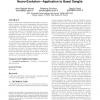418 search results - page 56 / 84 » Model building using bi-level optimization |
GECCO
2005
Springer
14 years 1 months ago
2005
Springer
A quality-time analysis of multi-objective evolutionary algorithms (MOEAs) based on schema theorem and building blocks hypothesis is developed. A bicriteria OneMax problem, a hypo...
PDPTA
2007
13 years 9 months ago
2007
Abstract - We have experienced in our distributed applications that the network is the main limiting factor for performances on clusters. Indeed clusters are cheap and it is easier...
JCAMD
2010
13 years 6 months ago
2010
When we build a predictive model of a drug property we rigorously assess its predictive accuracy, but we are rarely able to address the most important question, “How useful will...
CVPR
2010
IEEE
14 years 4 months ago
2010
IEEE
We present two novel methods to automatically learn spatio-temporal dependencies of moving agents in complex dynamic scenes. They allow to discover temporal rules, such as the rig...
GECCO
2010
Springer
14 years 22 days ago
2010
Springer
Neuro-evolution and computational neuroscience are two scientific domains that produce surprisingly different artificial neural networks. Inspired by the “toolbox” used by ...


